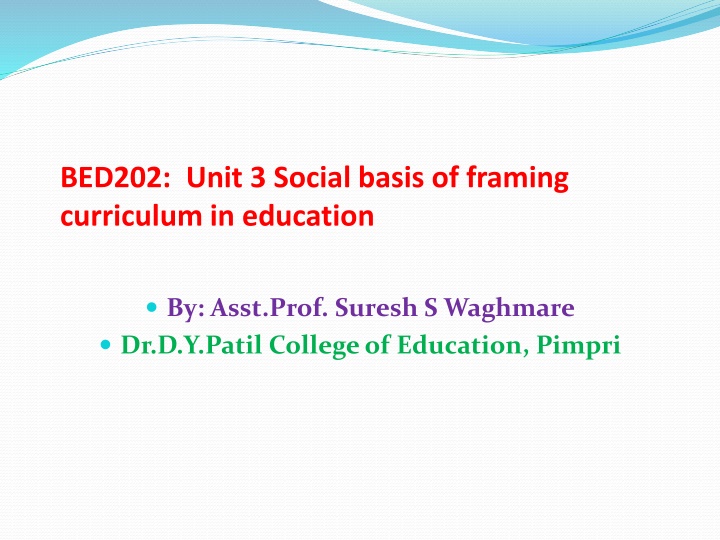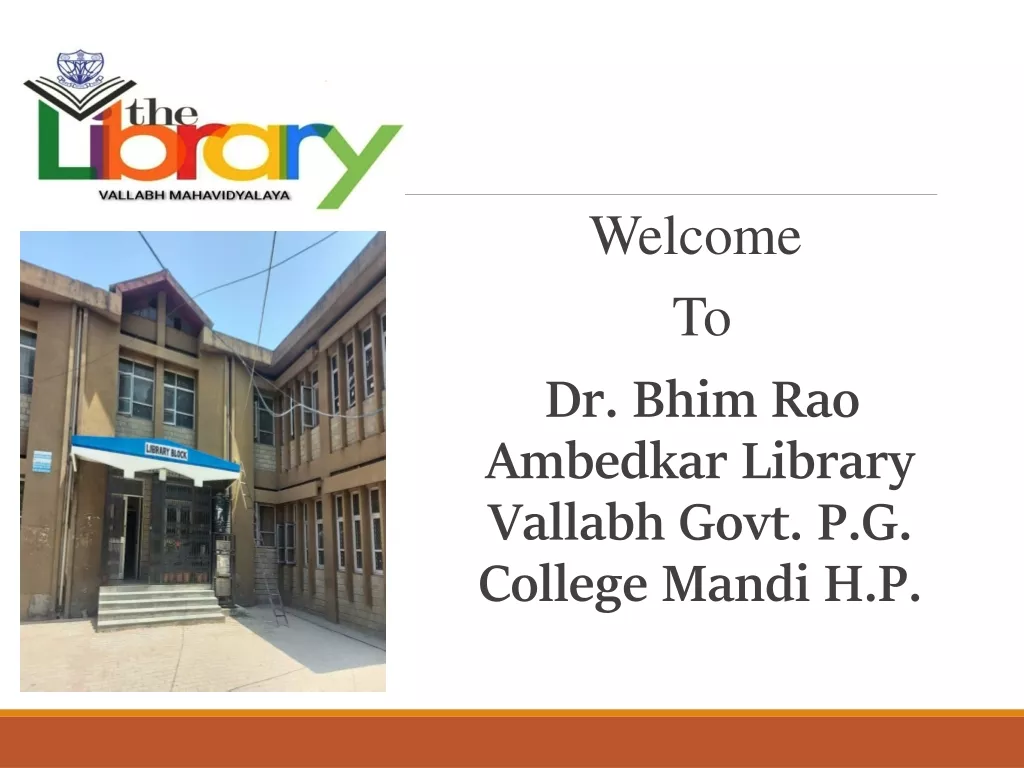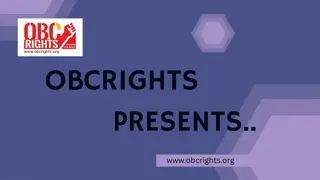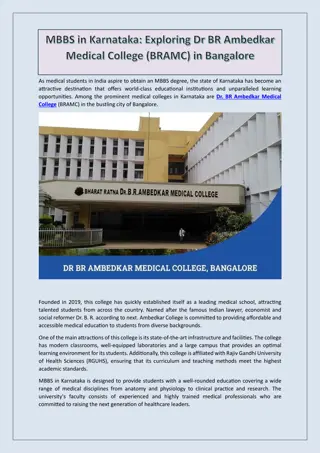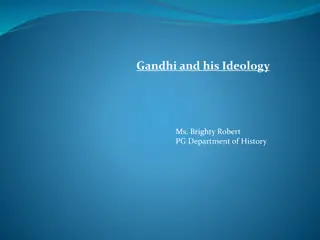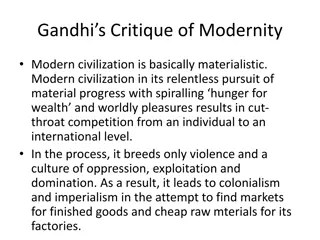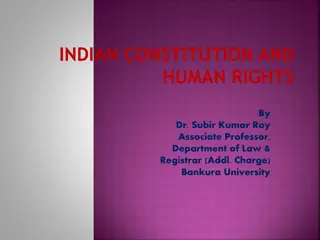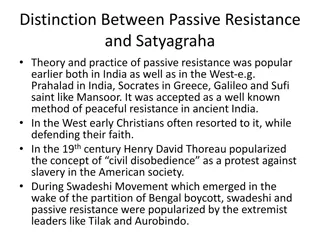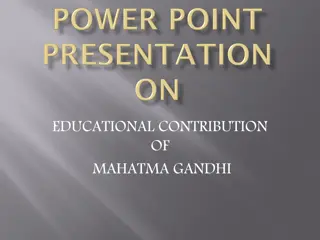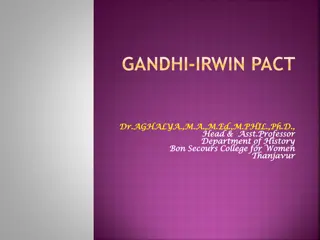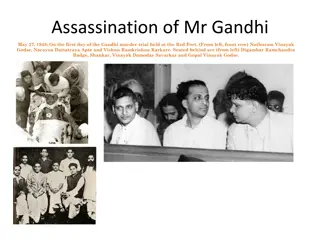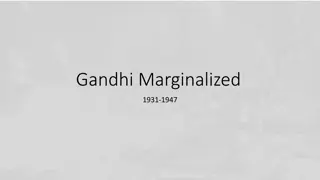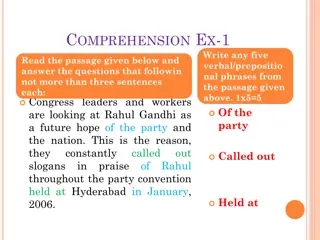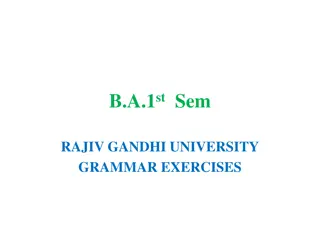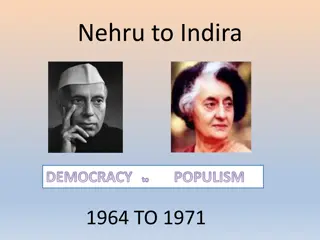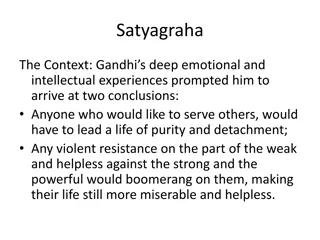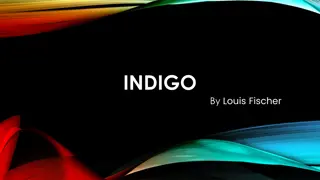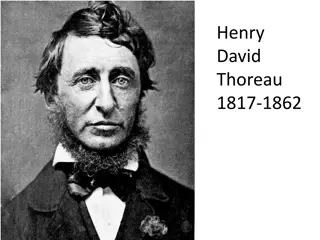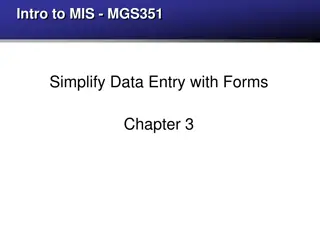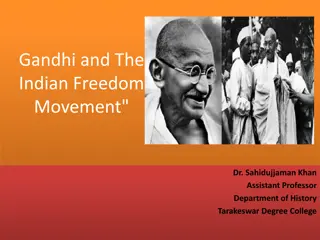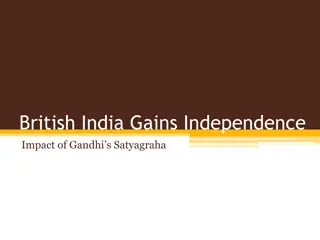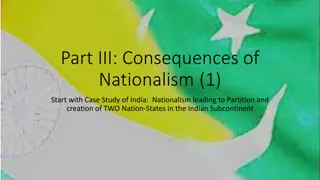Perspectives on Education: Dr. Ambedkar and Gandhi's Views
This text delves into the social basis of framing curriculum in education, exploring the values in the Indian Constitution reflected in secondary education. It discusses Dr. Ambedkar's and Gandhi's views on secondary education, emphasizing objectives like character building, self-discipline, and inculcating democratic values. Gandhi's perspective emphasizes holistic development and the ultimate aim of education as realizing God. It also highlights teaching methods and curriculum suggestions based on their philosophies, shedding light on the importance of basic education schemes.
Download Presentation

Please find below an Image/Link to download the presentation.
The content on the website is provided AS IS for your information and personal use only. It may not be sold, licensed, or shared on other websites without obtaining consent from the author.If you encounter any issues during the download, it is possible that the publisher has removed the file from their server.
You are allowed to download the files provided on this website for personal or commercial use, subject to the condition that they are used lawfully. All files are the property of their respective owners.
The content on the website is provided AS IS for your information and personal use only. It may not be sold, licensed, or shared on other websites without obtaining consent from the author.
E N D
Presentation Transcript
BED202: Unit 3 Social basis of framing curriculum in education By: Asst.Prof. Suresh S Waghmare Dr.D.Y.Patil College of Education, Pimpri
Values in the Indian Constitution and their reflection in curriculum of secondary education
Dr.Ambedkars view on Sec.Education Objectives Character building All round development Developing self discipline Realizing difference between what is good 7 bad, right and wrong Inculcating democratic values Creating the spirit of love for the nation Teaching methods: Self learning, Discussion, Lecture method. Started concept of morning colleges.
Gandhi's view on Sec. Education Meaning of Education According to Gandhiji literacy is neither the beginning nor the end of education. This is only a means through which man or woman can be educated . Gandhiji observes by education I mean an all round drawing out of the best in child and man- body, mind, and spirit. This is only a means through which man and woman can be educated. This is how Gandhiji summed up his idea of trueeducationaccordingly. EDUCATION IS DEVELOPMENT: All round implies harmonious development. Drawing out the best recognizes a great potentiality coiled up in the child which can be realised and developed to its perfection through education. It is development of human personality in terms of physical, intellectual and spiritual aspects.
ULTIMATE AIM OF EDUCATION According to Gandhiji, the ultimate aim of education is to realize God. Immediate Aims of Education Self-supporting aim Cultural development Character building All round development Cultivation of higher values of life Social uplift and welfare Dignity of labour: Curriculum Basic craft Agriculture, Spinning, Weaving, Leather-work, Metal-work ,Basket-making, Book-binding, Pottery etc. Mother tongue as the medium of instruction. Mathematics useful for craft and community life. Social studies social and economic life of the community, culture the community, history of craft etc. General science nature study, zoology, physiology, hygiene, physical culture, anatomy etc. Drawing and music
Methods of teaching Lecture, questioning and discussion method. Oral instruction to personal study. Teaching through creativeand productive activities Learning by doing Correlation technique Encouragementshould be given to learning by experience. Basic Education Scheme Free and compulsory education forall from 7 14 years To materialize the vision of society Gandhi evolved a scheme of education after many trials and experiments over a period of 40 years. His ideas revolutionized the current thinking about education. This scheme of education is known as Basic education or Wardha scheme of education or Nai Talim or new education or Buniyandi Shiksha.
Features of basic education The core aim of basic education is to help students to develop self sufficiency. Basic education laid a strong emphasis on manual work. There should be free, compulsory and universal education within the age group 7 to 14. It envisages providing education through the medium of work so that the child gains economic self The medium of education should be mother tongue. Education should develop human values in the child. It is aimed to achieve the harmonious development of the child s body, mind heart and soul. In basic scheme education is imparted through some local craft or productive work. The basic education is self supported through some productive work. It is geared to create useful, responsible and dynamic citizens. Play is an essential part of basic education. Subjects are taught in correlation with craft, with environment and with other subject. craft or productive reliance for his life.
Role of teacher: He wanted the teacher to be a model of behavior an image of society a compendium of virtues. He wanted teachers to teach by example than by precept. He opposed corporal punishment. A teacher should be the epicene of character, a symbol of values, well disciplined, a unique personality, cultured and having a good mentality. His serenity and magnanimity should be outstanding and shining. He should be polite, pious, and having sea of knowledge. He should be a psychologist, a philosophies, a historian, a technologist in the matters of knowledge and seduction.
Merits Basic scheme is an education for life, education through life, and education throughout life. Shortly, it wasa life centred education. This system is suited to our needs, requirements, genius, and aspirations for the future. The craft centred education will give greater concreteness and reality to the knowledge acquired bychildren. It synthesized the individual and social aims of education. It wasa need based education which curtailed rural unemployment. Gandhiji s scheme was highly practical as it starts with action rather than reflection. Basic scheme takes in to account the needs, interests and aptitude of the child. Thus it is essentiallychild centred. The basic scheme was nationalist in setting, idealist in nature and pragmatic on one hand whilesocial in purpose and spiritual in intent on theother hand. The Wardha scheme is non theoretical and as such it enables the student to undertake independent action. Basiceducation provides for the inculcation of an attitude of truth in children.
Demerits The over emphasis on crafts and productive activity has often been criticized as child labour. It neglects education in terms of personality development and development higher mental abilities, The craft centeredness has resulted in enormous wastage of material as small children are not in a position to produce anything worth while. Schools would degrade as trade centres. It may arrest thechild s spontaneous development. Thecall forcorrelation becomes forced and unnatural. The basic scheme overlooked the possibilities of development of children. To serve as a medium for education the basic craft selected must answer the testof universality. Making handicraft as nucleus of teaching will amount to throwing the country further behind in thisage of science and technology. It is not up to the aspirations of the new generation of a digitalized world. higher intellectual
Tagors view on Sec.Education His Philosophy As a Vedantist: He had a firm belief in the philosophy of Veda. He believed in I am Brahma . There is a spiritual bond between man and man. As an Individualist: he believed in giving right type of freedom to individual. Every individual is unique. As an Idealist: He believed that the man should live for the ultimate truth which liberates us from cycle of birth and death. Had faith in absolute values. As a Spiritualist: He believed that every individual should try to attain spiritual perfection. As a Humanist: He preached human brotherhood, having faith in fundamental unity of mankind. He remarked that even God depends upon man for perfecting his Universe. As a Naturalist: He considered nature as a great teacher. God revealed himself through various forms, colors and rhythm of nature. Tagore s Internationalism: He was an ardent prophet of world unity. He believed in world brotherhood
Concept of Education According to Tagore, God reveals himself through nature more effectively than through man made institutions. Hence ,the education of the child should be under natural surroundings so that he develops love for all things around him According to Tagore, "That education is highest which not only imparts information and knowledge to us, but also promotes love and follow feeling between us and the living beings of the world
Aims of Education Self realization Mother tongue Intellectual Development Aims Social Freedom Development Corelation of objects
Aims of Education Physical development: To include activities like swimming, diving, climbing trees, plucking flowers, etc. Mental Development :According bookish learning, knowing the real living directly is true education. It not only promotes the acquiring of some knowledge but develops the curiosity & faculty of learning and knowing so powerfully that no class room teaching can match it. Moral &Spiritual Development Education should strive for a number of moral and spiritual qualities like self discipline, tolerance, courtesyand inner freedom. Development of all faculties Chief aim of education should be the drawing out of the latent faculties of the child. To him a child is more important than himself problems hence he opposed the crushing of thechild's individuality. Hence he should be given full freedom. International Brotherhood Though Tagore was a individualist yet he believed in socialism, internalism. According to Tagore individual should develop to the fullest extent and then he should contribute his best to the promotionof international welfare to Tagore In comparison with
Curriculum Subjects: Literature and languages, Mother tongue, other Indian Languages and other foreign languages; Mathematics; Natural sciences such as Botany, zoology ,physics, chemistry, general science; health education; Social Sciences like geography, history, civics, economics, and Sociology; Agriculture and Technical Subjects; Arts, Music, Dance etc.; Philosophy; Psychology and Religion Broad-based Curriculum Activities and Occupations: Dancing Dramatics Music Games and Sports Drawing and Painting ,Excursions Agriculture and Gardening Regional Study Laboratory work Social Service Actual living and Community Service Broad-based Curriculum 1.Education through emotions through music, fine arts, painting, dance, dramatics and crafts 2. Education through mother-tongue but was not against of English language 3. Manual training for spiritual aspect found God in the labourer, the path- breaker and the tiller 4. Physical and Social Sciences real legacy is the cultural heritage of the whole community Curriculum : Other views
Teaching Methods Teaching by Walking: The mind in the class room does not remain active Hence by walking the mind remains active awake, hence the child easily grasp things Teaching by walking is the best method of education. Discussion & Question: Answer Real education is based on real problems of life hence question- answer method is effective wherein the teacher put the questions & ask the students to participate in discussions. Thus they gain essential knowledge. Activity Method: This method is of great importance because it activates all the faculties of the body & mind. In Vishwa Bharti, he made compulsory the learning of handicraft. He allowed any physical exercise or activity even during theclass teaching
Teacher Tagore gave an important place to teachers and asked them to carry out the following activities. 1.Believing in purity and in his own experiences, innocence of child, the teacher should behave with him with great love and affection, sympathy, affection. 2. Instead of emphasizing on book learning, the teacher should provide conducive environment to the child so that he engages himself in useful and constructive activities and learn by his own experiences. 3. The teacher should always be busy with motivating the creative capacities of the children so that they remain busy with constructive activities and experience. 4. Education can be successfully imparted by understanding childhood and giving oneself totally in love and union with it How the teacher is?
Multicultural education Multicultural education is an education for freedom that is essential in today s ethnically polarized and troubled world. It aims to create equal educational opportunities for students from diverse racial, ethnic, social-class, a helps all students to acquire the knowledge ,attitudes, and skills needed to function effectively in a pluralistic democratic society and to interact, negotiate, and communicate with peoples from diverse groups in order to create a civic and moral community thatworks forthe commongood.
Definition Multicultural education as a field of study is designed to increases education equity for all students. by Bank & Bank Multicultural education is a progressive approach for transforming education that holistically critiques & respond to discriminatory education. policies Paul Goraski & practices in
Multicultural education Components of multicultural education that are included in many educational programs are: ethnic ,minority, and women s studies; bilingual programs; cultural awareness; human relations; and values clarification
Integrating multicultural content into the curriculum involves four approaches: Contributions holidays, and discrete elements and is the most extensively used approach to multiculturalism in the schools. 2. Additive approach adds - content, concepts, themes and perspectives of minority groups to the curriculumwithoutchanging its structure. 3. Transformational approach: involves changing the structure of the curriculum to enable students to view concepts, issues, events and themes from the perspectivesof minoritygroups. approach: focuses on heroes, 1.
In social action approach: students make decisions on important social issues and take action to help solve them. Students feel empowered and proactive; they are provided with the knowledge, values and skills necessary to participate in social change. Student self examination becomes central in this approach through value analysis, decision making problem solving, and social action experiences.
Unit 4 Language & Curriculum It is the system of words or signs that people use to express thoughts &feelings to each other. Characteristics Verbal, Vocal Systematic Structured Symbolic Acquired dynamic
Home Language/ Family language/Native language/Mother language Dialect is a particular form of language which is peculiar to a specific region or social group. There are over 720 dialects in India. Foreign language is a language native to another country.
Multilingualism Multilingualism can be defined as an occurrence regarding an individual speaker who uses two or more languages, a community of speakers where two or more languages are used, or between speakers of two languages. A multilingual person is called as a Polyglot
Features of Indian multilingualism Multilingualism is sustained in India by social institutions. saamaaijak saMsqaad\vaaro BaaratamaQyao bahuBaaiYakta kayama Aaho. Multilingualism is the result of nationalism. bahuBaaiYakta raYT/vaadacaa pirNaama Aaho. Linguistic features transcend genetic boundaries. BaaiYak vaOiSaYTo AnauvaaMiSak isamaapoxaa EaoYz Aahot. Change in linguistic codes or their mixing in communication does not create problems of identity, conflict and crisis.
It is possible to become multilingual without being multicultural. Language boundaries because of regular contact are fuzzy. Indian multilingualism is bifocal, existing both at mass and elite levels. The functional relation between languages is not linear but hierarchical.
Importance Accessibility to knowledge of other cultures; Communication between different linguistic and cultural groups become easier Increases job opportunities High cognitive development of a child; A broader world view, etc
Reasons of Multilingualism Migration or labor mobility. sqalaaMtr ikMvaa kamagaar gaitiSalata Cultural contact : saaMskRitk saMpk- Annexation and colonialism : AMmalabajaavaNaI AaiNa vasaahtvaad Commercial : vyaavasaaiyak Technological : taMi~k Territorial conquest: p`adoiSak ivajaya
Types of Multilingualism Types of Multilingualism Individual Multilingualism vaOyai@tk Societal Multilingualism Manner of Acquisition Degree of Acquisition Ambilingualism sava- BaaYaavaad Natural bilingualism
